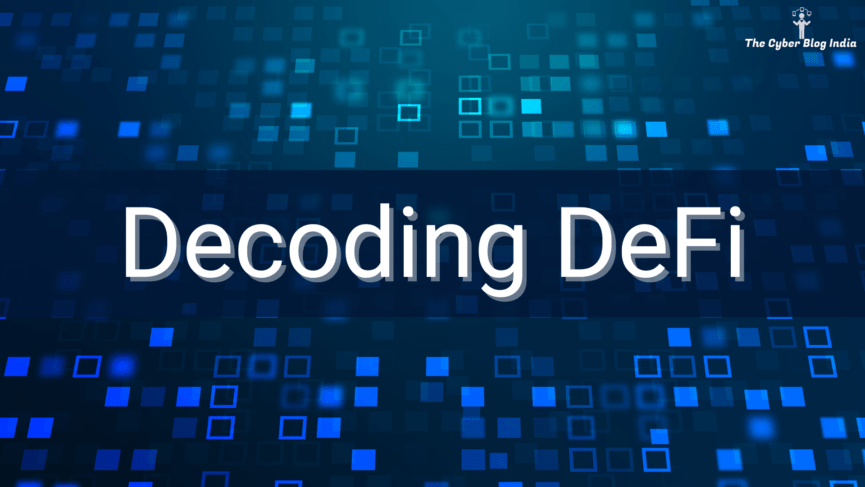Decoding DeFi


Can you imagine a world where loans, insurance, and every other financial service exist in a blockchain, just like cryptocurrencies? It sounds exciting and, at the same time, complicated. This is what decentralised finance (DeFi) is all about. DeFi is a borderless global system where customers can directly avail themselves of financial services on a decentralised blockchain. This means that middlemen like brokers will not have any control over the system. As a result, a customer can avoid paying for what those middlemen charge.
If you would like to read more on how the underlying blockchain technology works, you should read this article. A DeFi system uses smart contracts and cryptocurrencies to provide financial services without the bank’s involvement in the transaction. Smart contracts in a blockchain system get triggered automatically when parties meet the contractual conditions. Alongside smart contracts, DeFi systems rely on decentralised apps (DApps). DApps are similar to traditional apps; however, they operate autonomously and run on a blockchain or peer-to-peer (P2P) network.
Brief History
After the introduction of Bitcoins in 2008, blockchain technology has slowly gained popularity over the years. Moreover, it has been adopted for various applications, as I discussed here. DeFi did not have a definite name and recognition as today until 2018. A group consisting of entrepreneurs and software developers coined “DeFi”. It is an umbrella term for all open-source financial applications built by that time. Key features of a DeFi system are:
- It removes the service fees charged by brokers, banks, and other middlemen.
- No entity controls the system, and users do not require permission to avail services.
- Specific applications like synthetic assets and flash loans only exist on blockchains.
- Users can swiftly make payments.
Advantages
- Transparency: Users can verify every aspect of the system due to its inherent transparency.
- Financial security: A DeFi system is considered secure due to the tamper-proof nature of the underlying blockchain technology.
- Absence of financial institutions: DeFi systems do not have a centralised structure where a regulatory authority controls everything, including relationships between financial institutions and end-users.
- Avoid charges: DeFi systems do not have middlemen, and hence, users do not need to pay service charges to financial institutions involved in the transaction.
Disadvantages
- Risks involved: DeFi systems can have technological, asset, and product risks. For example, vulnerabilities in code can result in the overall system’s weakness.
- Volatility: Cryptocurrencies are highly volatile as their values fluctuate constantly. However, system developers can rely on cryptocurrencies that are extremely stable and are known as stablecoins. Stablecoins are quite useful for cross-border transfers without worrying about the volatility factor.
- Proper regulation: With no regulatory mechanism in place, the lender may not hold the borrower accountable under any existing law to recover dues.
- Heavy-duty computing: Managing a DeFi system is a computationally expensive process.
Before deciding whether you wish to use a DeFi system, as Mark Cuban says, “do your research”.
Centralised v. decentralised finance
One can understand DeFi better by differentiating traditional financial systems from decentralised systems. Here are three significant differences to keep in mind:
- Banks and other financial institutions control the transactions in a centralised system. On the other hand, no single entity controls your transactions in DeFi.
- Centralised systems involve intermediaries like banks and brokers. In DeFi systems, smart contracts replace intermediaries to ensure that parties fulfil their obligations.
- To borrow from a bank, you will need to verify your identity and possess a good credit score. In certain cases, banks can also ask for collateral. In a decentralised system, customers can remain anonymous and keep their identities secret.
Conclusion
In October 2021, an Economic Times report noted that the Reserve Bank of India (RBI) plans to red-flag DeFi platforms. The reason is that India does not have any statute or regulation to deal with either blockchain or cryptocurrency. Further, the cryptocurrency heist at Poly Network, a DeFi platform, has highlighted many unanswered questions and ambiguities in the system. From January to July 2021, the hackers stole $613 million worth of digital currency from the platform. Therefore, DeFi is still a work in progress, and it can take a while before such systems see massive adoption.
Featured Image Credits: Digital assets photo created by rawpixel.com – www.freepik.com
